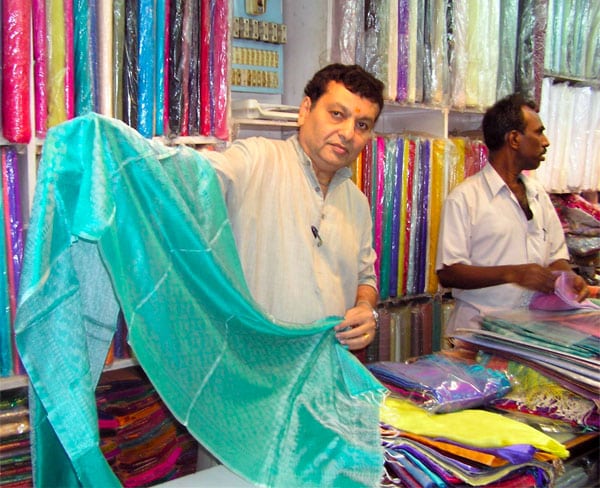
Silk vendor at D. Popli & Sons in Mumbai displays high-quality yet reasonably priced silk. Photo by Jacqueline Swartz
By Jacqueline Swartz
Mumbai, the city formerly known as Bombay, is the marketplace of India — its jewelry, textiles, handicrafts, furniture and leather goods come from all over India and around the world. This is India’s city of commerce and the arts; it’s where you find its major museums and its film industry. The Taj Mahal might be far away, but the Taj Hotel Palace sits royally overlooking the Arabian sea and near the arch called the Gateway of India, where the British departed in 1947.
One of the most striking things about Mumbai, as in other parts of India, is seeing women dressed in brilliantly colored saris, cunningly draped fabric with creatively combined colors. Purple and red? Fine. It made me, dressed in khaki pants and a white blouse, feel like a wren among parrots.
Now that I was in this is the epicenter of Indian commerce, what better way to experience the place than to shop?
Besides, I had a mission: “Fabric wanted,” said the e-mail from my sister in New York. She needed silk for curtains, and her color sense was both exacting and daring. “I want diaphanous iridescent orange or blue with yellow or orange tinges,” she wrote. “Should be high quality. For $50 or so you should be able to get almost 10 yards, which, if you mail it, won’t be a hassle.” In addition, she wanted a scarf: “a beautiful, long, floaty scarf with gold or silver threads — main color should be in orange or green.”
Luckily for her, I was in the center of the Indian silk universe. How hard could it be?
Silk is the Queen of materials. The most lovely, the most feminine, the most
enchanting with all the qualities Nature gives to things that we cannot make ourselves.
Christian Dior
I avoided Mumbai’s sprawling suburbs, which include both Bollywood studios and wretched slums, as well as a multitude of malls. The real Mumbai, as far as I was concerned, is the oldest part of this island city, the southern part, the business and media, academic, cultural and government center. This is where the British built their still-towering public buildings. Take the neo-Gothic railway station, still called the Victoria Terminus, but officially renamed Mumbai Chhatrapati Shivaji (or CST). Here, you have it all: the politically correct name change, the continuing use of the old, and the propensity for acronyms. Completed in 1887, it is adorned with turrets and buttresses, domes and spires, and carvings of gargoyles and monkeys. The post office and the town hall are also fine symbols of 19th-century colonial grandiosity.
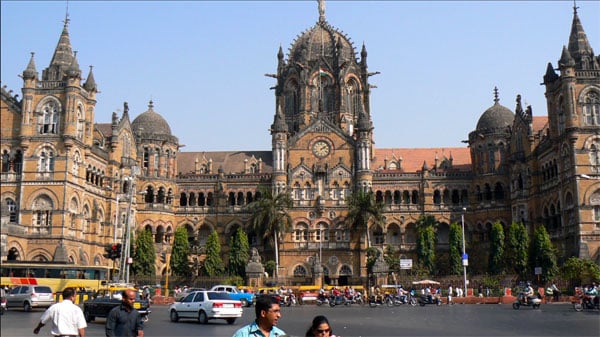
Mumbai’s train station officially is called Chhatrapati Shivaji (or CST), but most people still call it Victoria Terminus since it evolkes the British Raj in all its imperial glory. Photo by Jacqueline Swartz
I headed to the Colaba Causeway, a strip of land built to connect the islands adjacent to Mumbai with the city. Here where vendors line the streets and bargaining is the name of the game. From Indian blouses, known as kurtas, to costume jewelry, belts and sunglasses, this is the place to get good stuff for cheap prices. For a few dollars, I bought a black-beaded evening bag and blouse for a friend. There were blouses made of silk but no fabric. And the scarves were not what I was looking for.
Silk has been part of Indian culture ever since it was brought to the Indian Subcontinent in 2500 BC by Chinese traders. It wasn’t part of the first Silk Road trading route, but it was included in the route, pioneered by the Ming Dynasty. This route went from Canton down the China sea, across the Bay of Bengal and then up the Red Sea. The area around Mumbai was a trade stop.
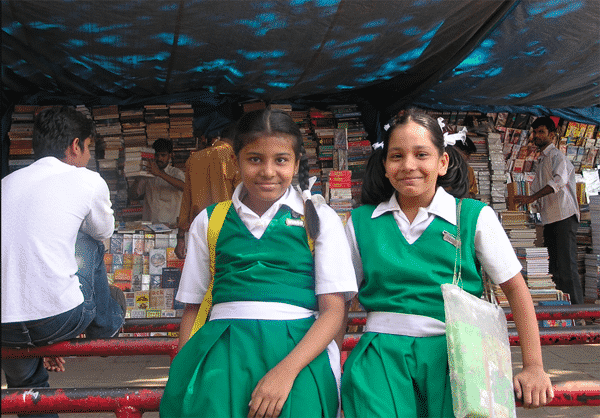
Mumbai school girls also enjoy shopping in the stalls near the Colaba Causeway. Photo by Jacqueline Swartz
During the Mughal Empire that controlled much of South Asia between the 16th and 19th, centuries, weavers of silk were prized. The opulence and colors of silk announced luxury and wealth. They still do. The skill became multinational, as artisans were brought in from Persia and Turkey. Brocades from these countries influenced Indian patterns and techniques.
Today, India is the second largest producer of silk in the world after China. Mumbai is the trading center, but silk is made in the states of Karnataka, Andhra Pradesh, West Bengal, Tamil Nadu and Jammu.
India is the only country where the five major types of silk are made. The most common is mulberry silk, spun by the silkworm that feeds on the leaves of the mulberry tree. Silk, it turns out, is a fabric classic. The ways of processing it are similar to those in the ancient world. And like back then, it is worn at weddings and other gala events.
Silk production is labor intensive and provides employment for large numbers of small and marginal farmers. According to the National Commission on Agriculture, there should be more of it. The demand is certainly there. But China has been criticized for dumping silk at a cost so low that Indian producers can’t afford to compete.
A short walk from the chic Ambassador Hotel, where I was staying, is the Oberoi Centre, a cluster of boutiques adjacent to the Oberoi Hotel. The shiny granite and hushed air-conditioned halls are the antitheses of the noisy Colaba scene. Here I saw affluent shoppers in what surely were silk saris. Silk, in this heat? The shimmering fabric breathes. And of course there is air-conditioning for those who can afford it. For the rest, there is cotton or even cheaper synthetics. No matter what the fabric, saris can be wrapped in dozens of ways.
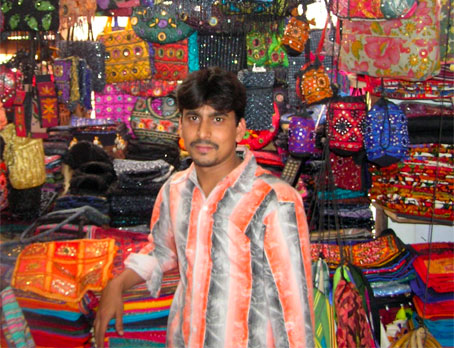
Mumbai began trading with China as early as the Ming Dynasty. Today it is India’s leading shopping city with colorful markets located throughout town. Photo by Jacqueline Swartz
Leaving the chic, Oberoi Centre’s Farheen Collection store, I was asked by the salesman what I’d really like to pay for the fringed brown and beige silk-and-cashmere shawl I had examined. I never imagined that bargaining would be the norm, but I bought it for half the original price. Across the hall was the boutique of internationally noted Indian designer Ritu Kumar. There were jeweled T-shirts, embroidered skirts, silk day dresses– a very Indian take on fashion.
But nowhere could I find the right silk fabric. And mailing it out from a store, I discovered, was going to be pricey. “What you want is just not here,” I e-mailed my sister, “although I did see some interesting lime green and saffron colors. Also, the prices seem to be about $10 a yard and mailing is not so simple.”
The government-run Central Cottage Industries Emporium was supposed to be a good bet. It’s a dimly lit place with rugs and carved wood, jewelry and brass — and fabric. There is no bargaining, and it’s relatively expensive. But I was getting anxious. I bought my sister a scarf of buttery silk that I suspected was not quite right. It came with a lesson in public-sector bureaucracy. How many people does it take to sell you a scarf? Probably about four. One to help you choose it, one to write it up, one to take your cash, one to stamp the receipt and hand it over to you.
Failing in my silk quest, I headed for a shot of culture. Mumbai has lots of bookstores and even more outdoor vendors, especially around the gothic revival Flora Fountain, in the south Mumbai business district. The most venerable store, the Strand Book Stall (“Where the reader comes first”), is more than 50 years old and is still run by its founder, T.N. Shanbhag. The cramped two floors were surprisingly well organized, with the books arranged by publisher. What impressed me most, though, were the prices — about half of what I’d pay at home.
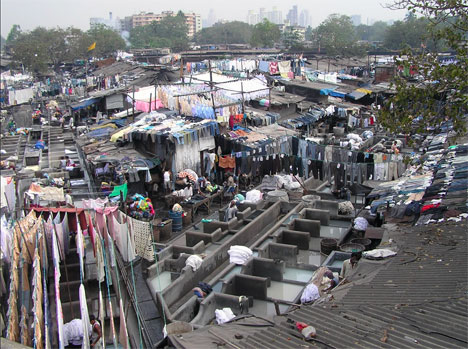
Dhobi Ghat is Mumbai’s outdoor laundry where over 5,000 laundrymen pick up, wash, fold and deliver soiled clothes and linens for families across the sprawling metropolis
My next stop was the Fabindia fabric store, middle-class and ecologically correct, with detailed sign boards explaining that Fabindia cotton is organic, while most cotton is grown with nasty pesticides. It was all very educational, and it was fun watching mothers and daughters examine the fine cottons and elegant silk saris and scarves. Still, nothing was right.
My sister e-mailed me back — if it was going to be too much trouble, I should just forget about it. She added that lime green and saffron are some of her favorite colors, and $10 a yard is nothing compared with New York prices.
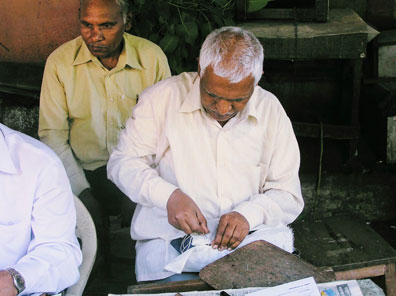
Outside Mumbai’s 19th Century post office men stitch a protective cover of muslin around air parcels that are then sealed with wax. Photo by Jacqueline Swartz
I was able to take her hints, thanks to a second-story store, D. Popli & Sons, in the Readymoney building behind the Regal Cinema. Its cellophane-wrapped merchandise was behind the counter, and its many customers were serious about buying. I suspected it was a wholesale store, and it had just what I was looking for. First the silk fabric– I bought five meters (about 10 feet) of orange and five of green for about $7 a yard. Then a patterned silk scarf for one friend, and a gossamer scarf with glitter for another.
Mailing it was like entering the 19th century. Across from the main post office, seated on a chair beneath a tree, a man wrapped my parcel in muslin, sewed it with string, put a wax seal on it and handed me a magic marker to address it. At the Dickensian post office, my parcel was weighed and I was charged about $12. After handing over those two packages, I felt free. Free to shop without pressure or purchase.![]()
WHERE TO SHOP
Farheen’s Collections: Oberoi Shopping Centre, The Oberoi, Nariman Point.
Ritu Kumar: Oberoi Shopping Centre
Fabindia: Jeroo Building, 137 Mahatma Gandhi Rd.
Central Cottage Industries Emporium: 34 Shivaji Mahraj Rd.
D. Popli & Sons: Readymoney Building, Battery St.
WHERE TO STAY
The Ambassador Hotel: V.N. Road, Churchgate
MORE INFORMATION
India Tourism
![]()
Jacqueline Swartz is an experienced travel writer whose work has appeared in major Canadian publications as well as Conde Nast Traveler and Agence France-Presse. Her last story from Asia’s sub-continent described India’s one-horned rhino in the Kaziranga Wildlife Preserve.

